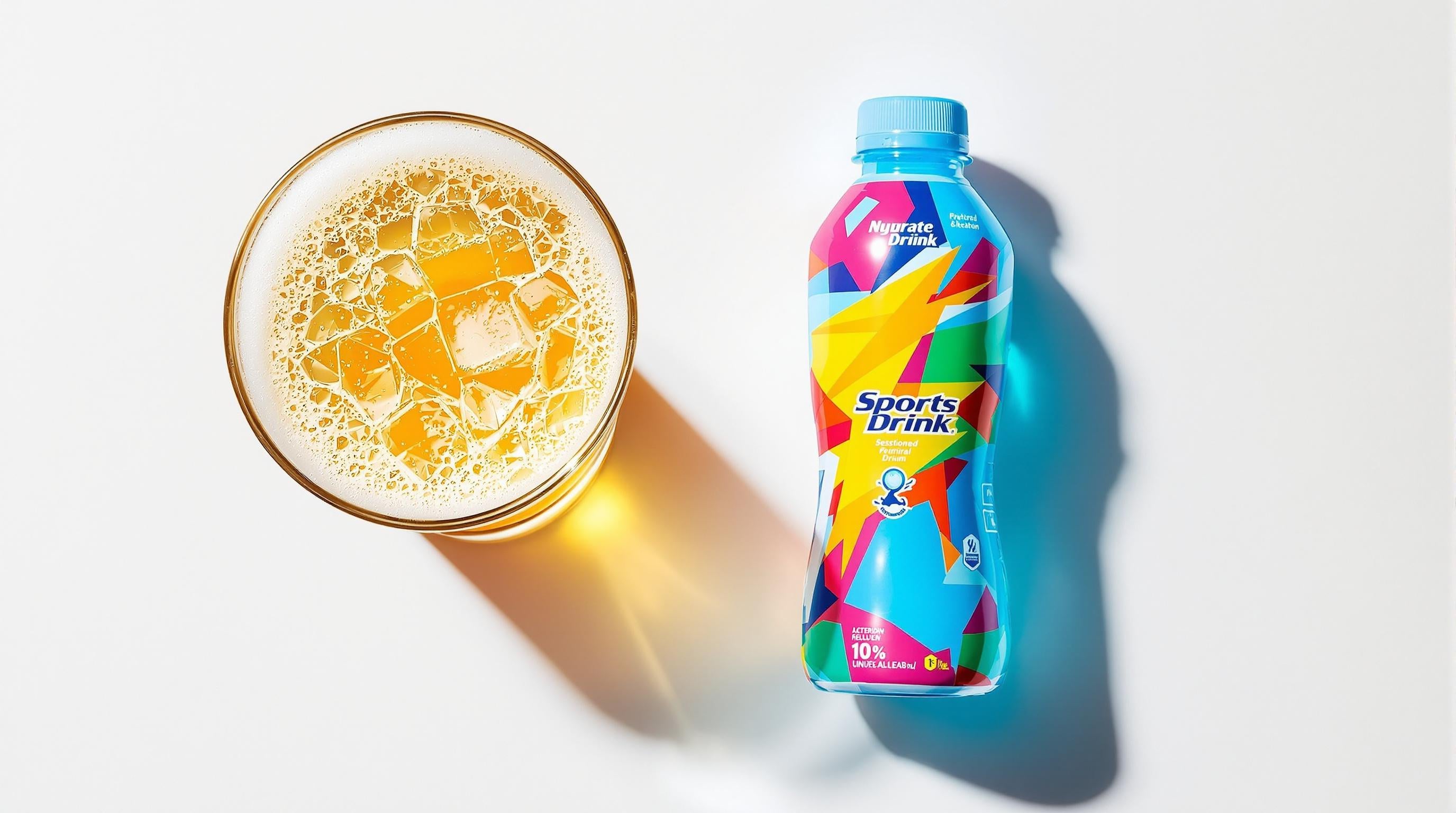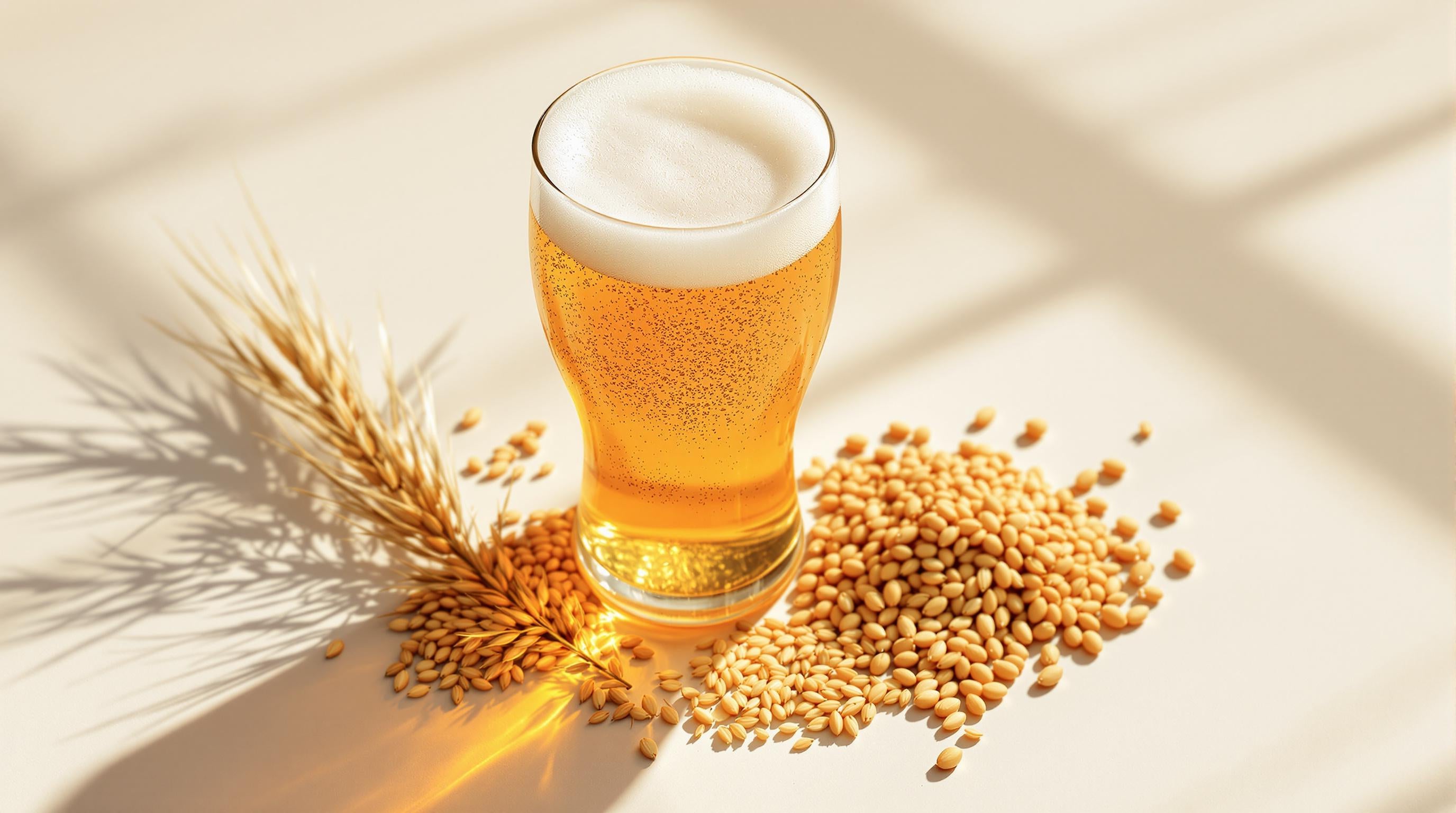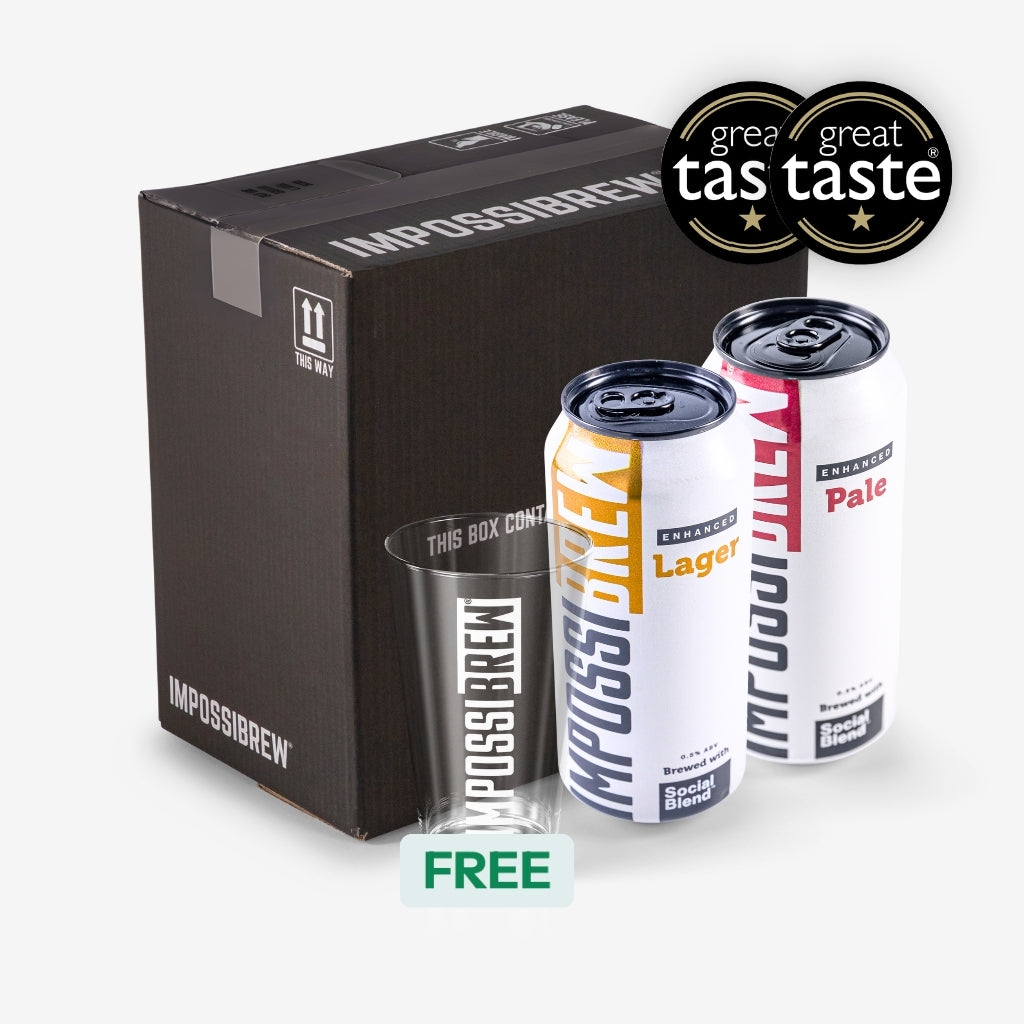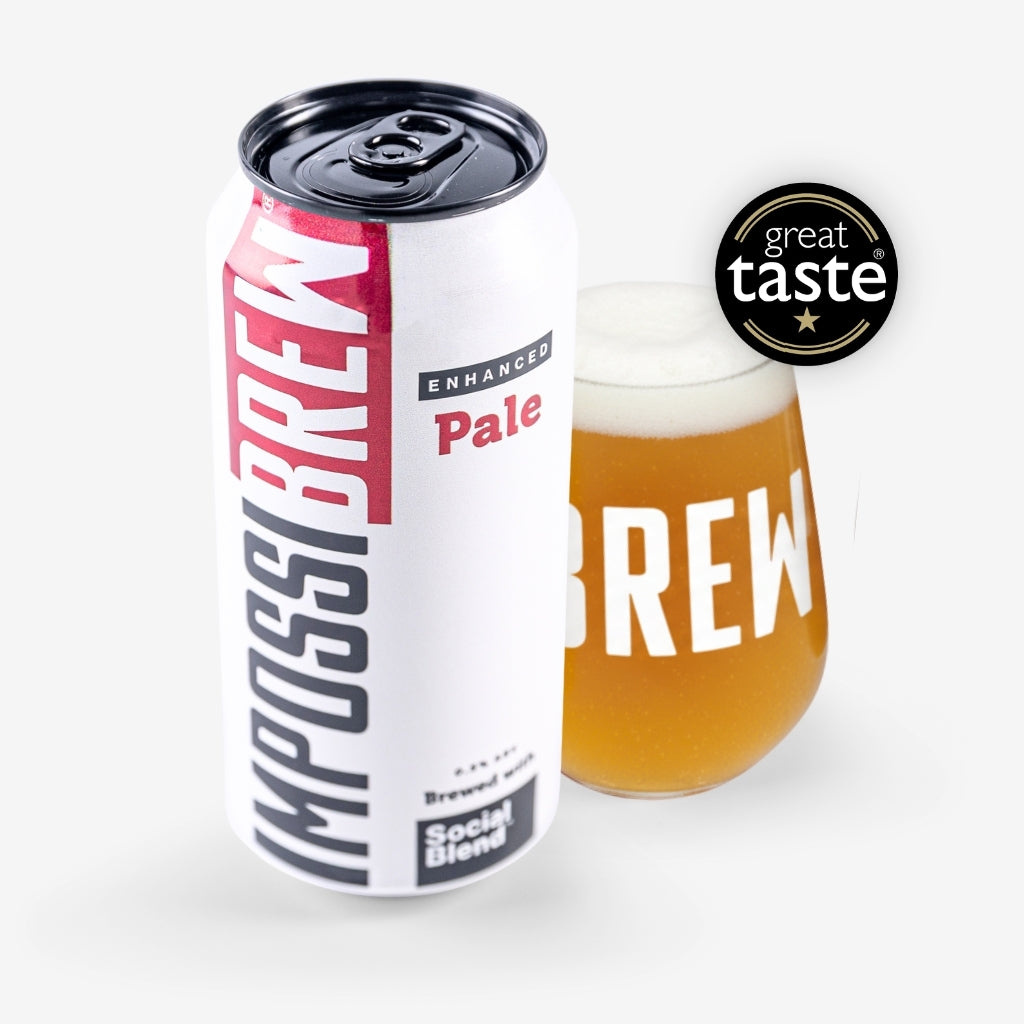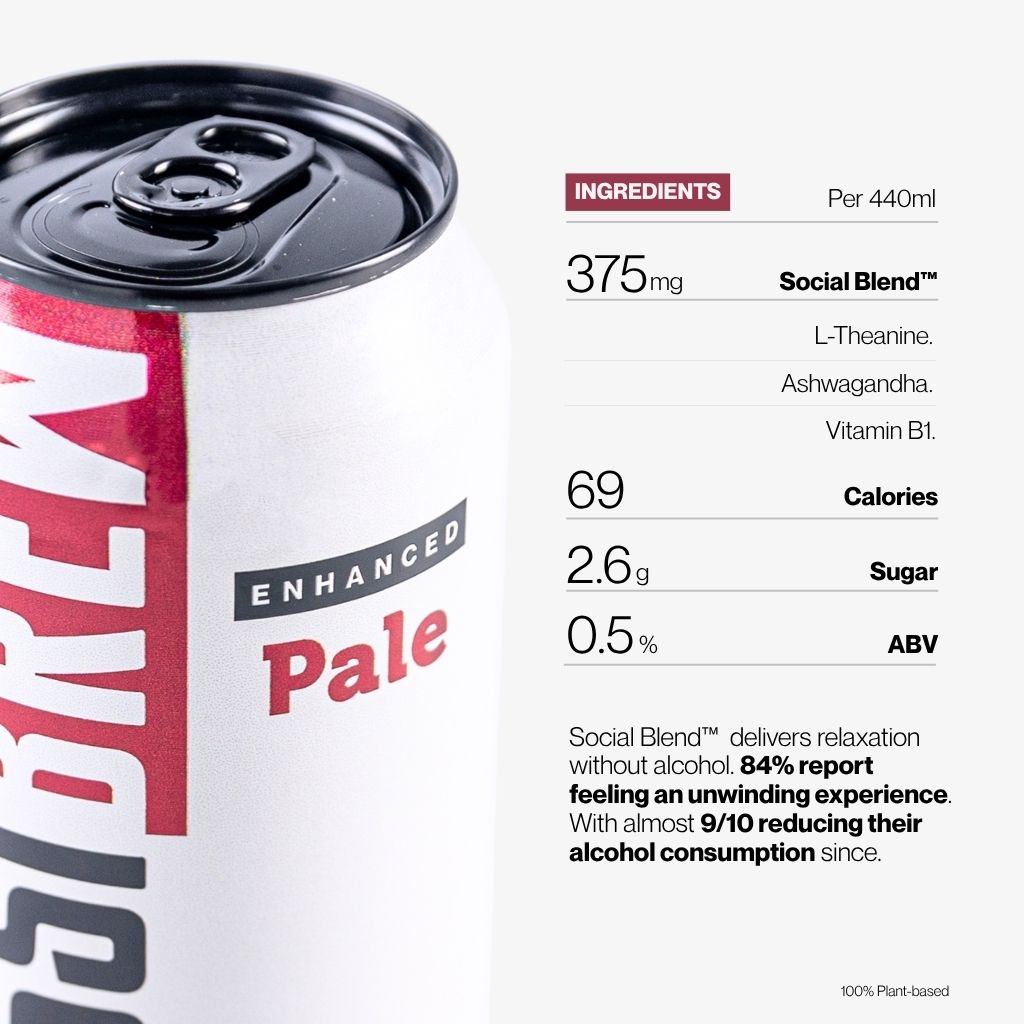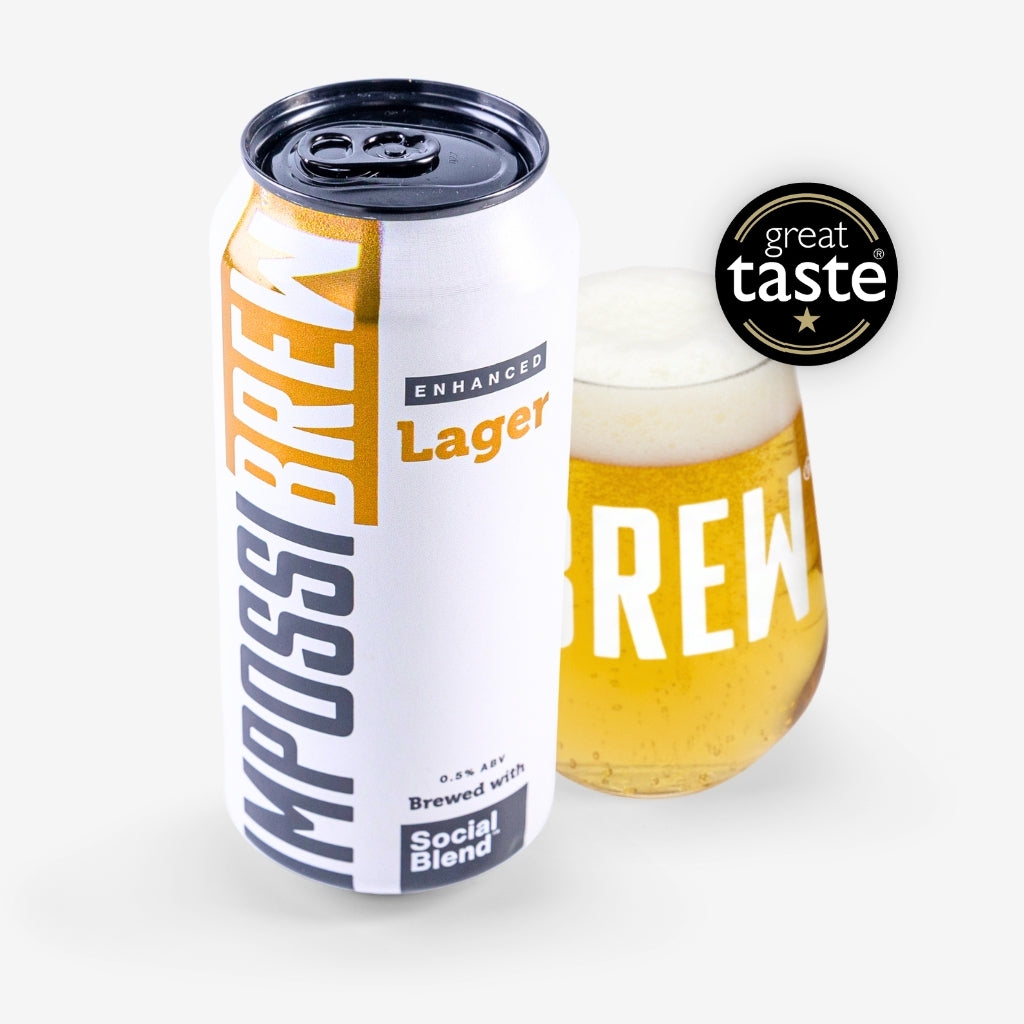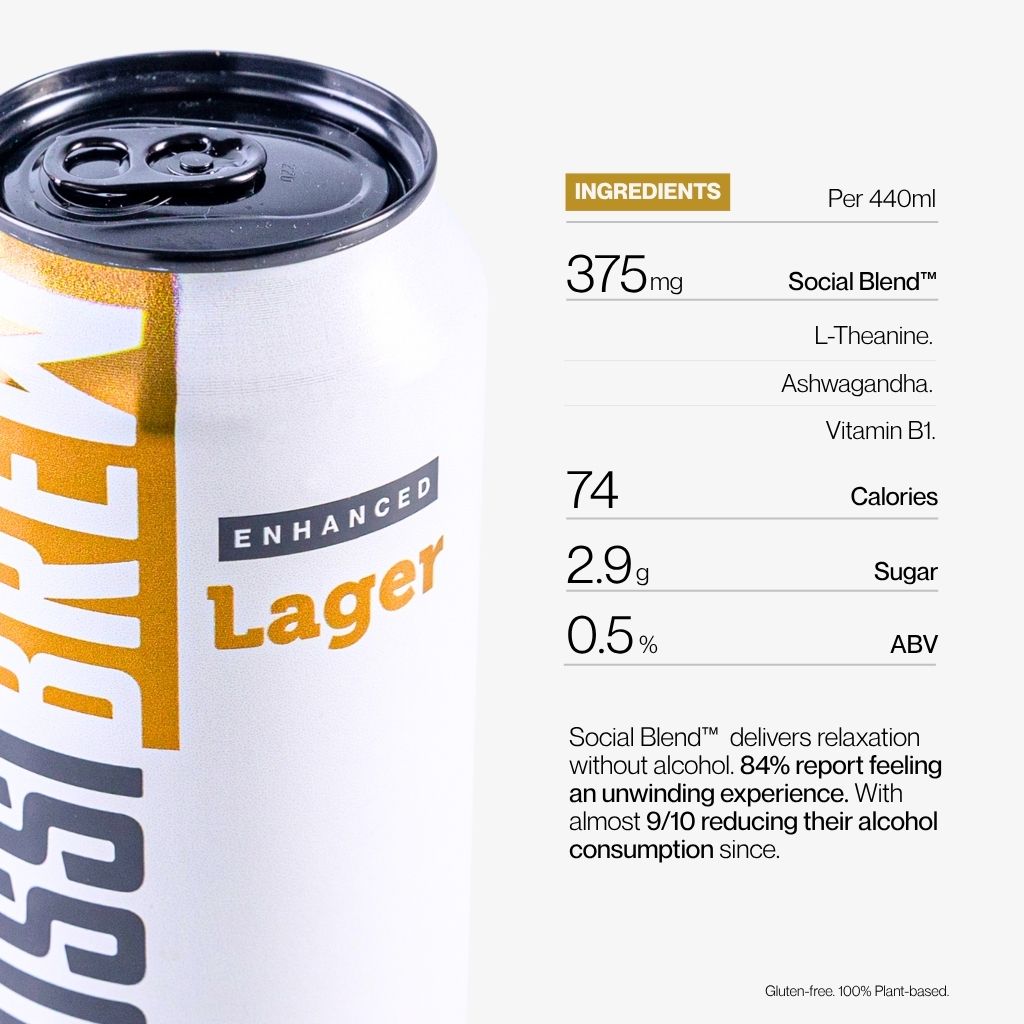How Science Enhances Non-Alcoholic Beer Flavor
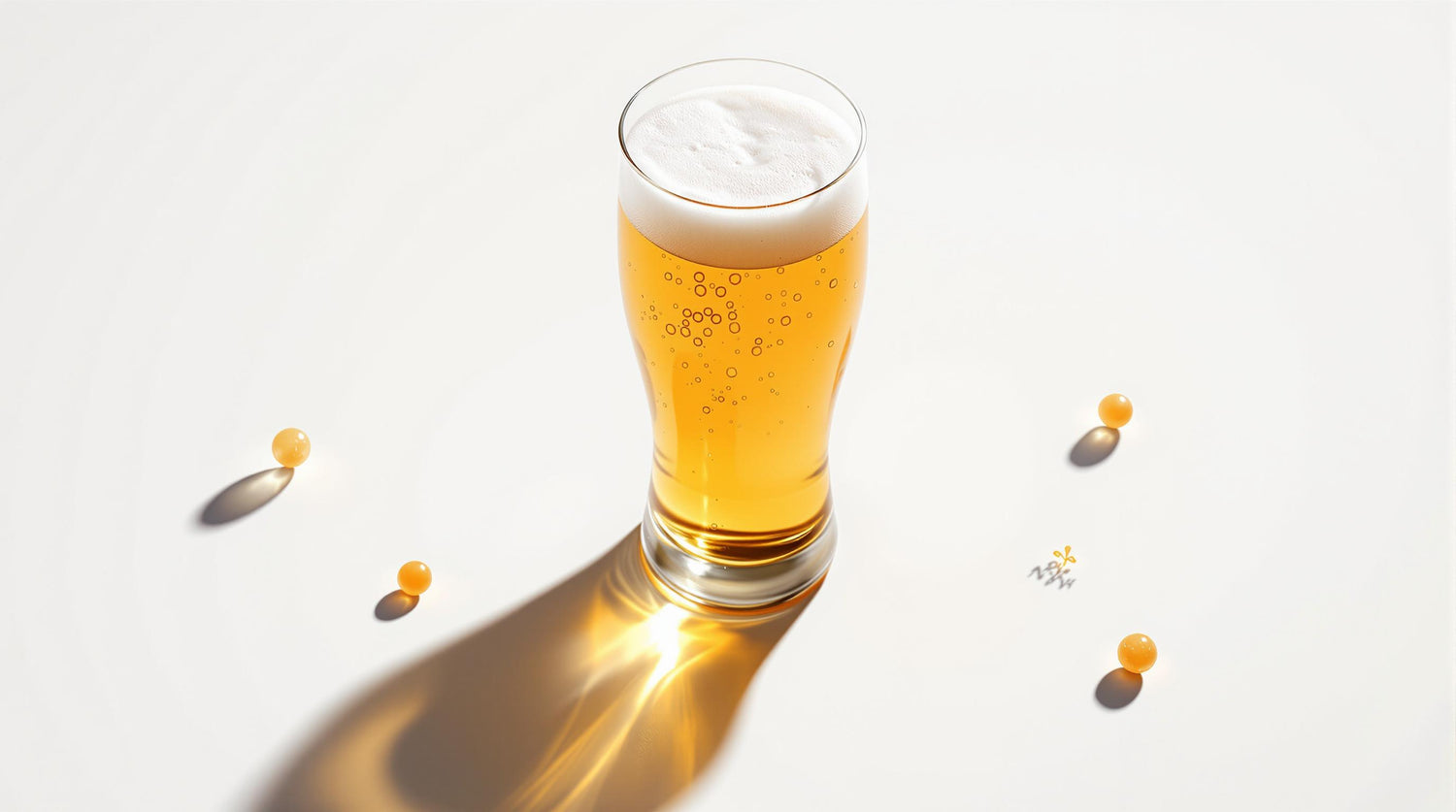
Non-alcoholic beer often struggles with blandness, lack of depth, and off-flavors because alcohol is key to carrying aromas and creating a rich flavor profile. But brewers are now using science to solve this. Here’s how:
- Genetically Modified Yeast: Produces hoppy compounds like monoterpenoids, recreating beer's aroma without alcohol.
- Cryogenic Fermentation: Stops alcohol formation while preserving natural flavors.
- Nootropic Ingredients: Adds compounds like L-Theanine and Ashwagandha to enhance taste and provide relaxation.
- Natural Extracts: Boosts complexity with hop and malt derivatives.
These methods are transforming non-alcoholic beer into a flavorful option that rivals traditional beer. Keep reading to learn how these innovations work and what they mean for the future of brewing.
Flavor Challenges in Non-Alcoholic Beer
Alcohol's Role in Flavor and Aroma
Alcohol plays a key role in delivering the flavor and aroma of beer. It helps preserve the hop compounds that give beer its distinct taste and smell. When alcohol is removed, this balance is disrupted, making it harder to achieve the complex flavor profile people expect from beer [5]. Without alcohol, many of the compounds responsible for the hoppy notes are lost, which poses a challenge for brewers.
Traditional methods of removing alcohol, like heating, often destroy the delicate aromatic compounds in beer [1]. This makes it tricky to maintain the rich sensory experience that drinkers associate with traditional beer.
Common Flavor Issues in Non-Alcoholic Beer
Non-alcoholic beers face unique flavor challenges due to the absence of alcohol. Here’s a breakdown of the main issues:
| Flavor Issue | Effect on Beer | Root Cause |
|---|---|---|
| Blandness | Lacks vibrant taste | Reduced extraction of hop compounds |
| Lack of Depth | Feels one-dimensional | Alcohol missing as a flavor carrier |
| Off-Flavors | Unpleasant notes | Changes in fermentation processes |
De-alcoholization methods often weaken or destroy the aromatic compounds that make beer enjoyable. This is a significant hurdle for brewers [5]. However, researchers are finding solutions. For example, a team at the University of Copenhagen has developed specialized yeast strains that can produce key flavor compounds typically carried by alcohol [1].
To tackle these flavor issues, brewers are exploring advanced techniques. These include using innovative yeast strains and experimenting with new ingredients to recreate the full sensory experience of traditional beer - without the alcohol.
Non-Alcoholic Beers and How to Brew Them
Scientific Methods to Improve Flavor
Brewers are tackling the challenge of improving non-alcoholic beer's flavor with cutting-edge techniques like genetically modified yeast and nootropic ingredients. These approaches are helping alcohol-free beer deliver a richer and more enjoyable sensory experience.
Genetically Modified Yeast for Flavor
Researchers at the University of Copenhagen have developed genetically modified yeast that brings back the hoppy flavors often lost in non-alcoholic beer. This yeast produces monoterpenoids, the compounds responsible for beer's signature aroma, without needing aroma hops. This ensures that key flavor compounds stay intact during brewing [1][4].
"This is a game changer for non-alcoholic beer", says Professor Kampranis [1][4].
While this yeast innovation focuses on restoring traditional beer flavors, nootropic ingredients offer a fresh approach by enhancing both taste and functionality.
Nootropic Ingredients for Taste and Relaxation
Nootropic compounds do more than just promote relaxation - they also help fill flavor gaps, making non-alcoholic beer more satisfying and well-rounded.
| Ingredient Type | Purpose | Impact on Flavor |
|---|---|---|
| L-Theanine | Promotes relaxation | Improves mouthfeel |
| Ashwagandha | Reduces stress | Adds depth to flavor |
| Plant Extracts | Boosts mood | Enhances aroma |
Brands like IMPOSSIBREW® are incorporating nootropic ingredients such as L-Theanine and Ashwagandha into their Social Blend™, using advanced fermentation methods to create complex, alcohol-free flavor profiles [2][3].
sbb-itb-a752bf8
Brewing Techniques for Non-Alcoholic Beer
Thanks to modern brewing methods, non-alcoholic beers now offer flavors that rival their alcoholic counterparts. These techniques are designed to maintain rich taste profiles while keeping the alcohol content at bay.
Cryogenic Fermentation: Keeping the Flavor Intact
Cryogenic fermentation uses extremely low temperatures to prevent alcohol from forming while preserving the beer's natural flavors. This precise method has become a game-changer in crafting non-alcoholic beer.
By carefully controlling temperatures, brewers can halt alcohol production without losing the compounds that give beer its unique taste. Here's a closer look at how this process works:
| Temperature Phase | Purpose | Flavor Impact |
|---|---|---|
| Pre-fermentation Cooling | Prepares ingredients | Protects hop aromas |
| Cryogenic Processing | Stops alcohol formation | Keeps malt richness intact |
| Post-process Temperature Control | Locks in flavors | Stabilizes aroma and taste |
While cryogenic fermentation ensures the beer retains its natural flavor, brewers often combine this with other techniques to refine the sensory experience even further.
Using Natural Extracts to Perfect the Taste
To mimic the complexity of traditional beers, brewers are turning to natural extracts. These extracts, including hops, esters, and malt derivatives, help replicate the bitterness, fruity undertones, and body of alcoholic beer.
For example, companies like EvodiaBio use modified yeast to produce key flavor compounds. These compounds can be added during the brewing process to enhance the beer's overall taste and aroma [1][4]. By combining these extracts with advanced brewing methods, non-alcoholic beers are achieving the depth and character that consumers expect.
Future Trends in Non-Alcoholic Beer
The non-alcoholic beer market is growing quickly, driven by advancements in science and shifting consumer preferences for bold flavors and eco-friendly production.
Consumer Demand for Strong Flavors
Generation Z is leading the charge for non-alcoholic beers that pack the same punch as their alcoholic counterparts. This demand has pushed brewers to experiment with new techniques to improve flavor profiles.
Professor Sotirios Kampranis calls these advancements a "game changer" for creating flavorful non-alcoholic beers [1]. For example, technologies like EvodiaBio's engineered yeast allow brewers to mimic hoppy flavors while reducing resource use.
Brands like IMPOSSIBREW® are also stepping up by using nootropic ingredients in their Social Blend™. This approach not only satisfies taste but also offers relaxation benefits, meeting the needs of today’s consumers [2][3].
Sustainability Through Science
Consumers are looking for drinks that taste great and align with their environmental values. Brewers are using cutting-edge technologies to tackle both.
| Technology | Eco-Friendly Benefit | Flavor Impact |
|---|---|---|
| Genetically Modified Yeast | Cuts down on aroma hop usage | Keeps hoppy flavors intact |
| Cryogenic Fermentation | Lowers environmental footprint | Preserves natural taste |
With the industry expected to grow at a CAGR of 7.1% from 2023 to 2030 [2], companies are pouring resources into methods that combine great taste with sustainability. These efforts highlight how science is reshaping the brewing process to meet modern demands for flavor and environmental care.
Brewers are adopting increasingly advanced techniques to balance taste and sustainability. This approach is crucial as consumers prioritize eco-conscious choices without compromising on quality or flavor in their non-alcoholic beverages.
Conclusion: Science and Non-Alcoholic Beer Taste
Science has reshaped the non-alcoholic beer industry, tackling challenges in flavor and overall sensory experience. For instance, genetically engineered yeast strains, like those developed at the University of Copenhagen, allow brewers to recreate rich hoppy flavors without the need for alcohol [1][5].
These breakthroughs don’t just improve taste - they also reduce the need for aroma hops, offering benefits for both flavor and resource efficiency. Techniques like cryogenic fermentation and the use of nootropic ingredients are further enhancing flavor retention and the overall drinking experience [1][5].
The combination of consumer interest and advancements in brewing science has led to higher-quality non-alcoholic beers. With improved brewing methods and ingredient innovations, brewers are now able to craft beverages that deliver complex flavor profiles while aligning with sustainability goals. This progress positions non-alcoholic beers as more than just substitutes - they’re becoming a refined beverage category in their own right.
These developments show how science is shaping the future of non-alcoholic beer, turning it into a choice driven by quality and innovation, rather than compromise. As consumer tastes evolve, these products are set to meet - and even exceed - expectations for flavor and complexity.
FAQs
Why does non-alcoholic beer taste flat?
Crafting non-alcoholic beer that doesn't taste flat or watery has been a challenge, but science is making impressive progress. According to Professor Sotirios Kampranis from the University of Copenhagen:
"What non-alcoholic beer lacks is the aroma from hops. When you remove the alcohol from the beer, for example by heating it up, you also kill the aroma that comes from hops." [4]
This happens because alcohol helps carry the aroma and flavor compounds from hops, which are often lost during processes like heating used to remove alcohol [1][4]. To tackle this, brewers are turning to innovative techniques to bring back those missing flavors and aromas.
| Solution | How It Works | Impact on Flavor |
|---|---|---|
| Genetically Modified Yeast | Creates hoppy compounds like monoterpenoids | Reintroduces hop aroma without needing alcohol |
| Cryogenic Fermentation | Prevents alcohol from forming during brewing | Keeps natural flavors intact |
| Natural Extracts | Added after brewing | Boosts flavor depth and complexity |
Companies such as EvodiaBio are working to make these methods widely available [1][4]. With non-alcoholic beer gaining popularity across Europe, these advancements are helping to create options that are both flavorful and satisfying for consumers. These new approaches are changing the game for alcohol-free beer lovers.
Related Blog Posts
Next Generation Alcohol-Free Beer
IMPOSSIBREW®: The Enhanced Non-Alcoholic Beer designed as an alternative to full ABV beers using patent-pending technology*.
Enjoy a healthier daily wind down with the beer that matches the taste and feeling of traditional alcohol.
Keep the pleasure and ritual of drinking without worrying about your health.
Get Started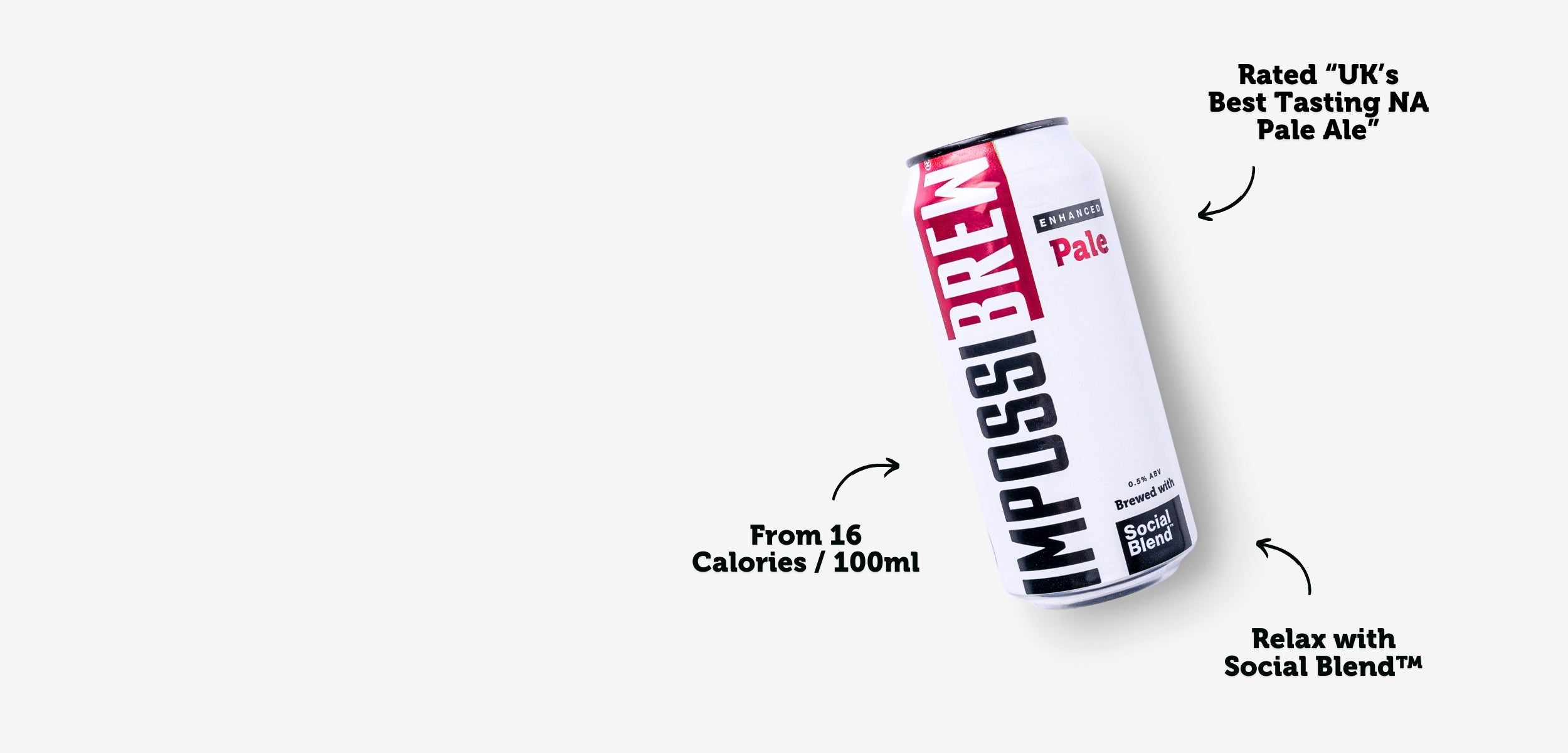
Next Generation Alcohol-Free Beer
IMPOSSIBREW®: The Enhanced Non-Alcoholic Beer designed as an alternative to full ABV beers using patent-pending technology*.
Enjoy a healthier daily wind down with the beer that matches the taste and feeling of traditional alcohol.
Keep the pleasure and ritual of drinking without worrying about your health.
Get StartedAward-winning Taste
Rated "UK's Best Non-Alcoholic Beer" by the prestigious World Beer Awards.
From 16 Calories / 100ml
Low Calorie. Low Carb. Vegan-friendly. <0.5% ABV. Gluten-Free (Lager)
Social Blend™
Our proprietary alcohol alternative made from a blend of science-backed ingredients designed to replicate the sensory, social and relaxing experience of drinking. Read more here.
Got Questions?
Find our most commonly asked questions below or ask our AI Brewer for instant answers.
What is IMPOSSIBREW®?
IMPOSSIBREW® is a pioneering non-alcoholic beer brand based in the UK that aims to create the world's most complete alcohol alternative using patent-pending technology.
Founded by Mark Wong in 2021 and working with some of the world's best professors, scientists and expert brewers, IMPOSSIBREW® specialises in expertly crafted non-alcoholic beers designed to match full ABV beers in both taste and feeling.
Product Range
IMPOSSIBREW® offers a range of enhanced non-alcoholic beers, including:
- Enhanced Lager (0.5% ABV)
- Enhanced Pale Ale (0.5% ABV)
- Limited Editions (Seasonal)
Key Benefits
The key feature that sets IMPOSSIBREW® apart is its proprietary "Social Blend™" - a combination of active botanical ingredients and nootropics using patent-pending technology* designed to recreate the relaxing effects of alcohol without the negative side effects.
Along with record-breaking quality flavour that comes from a unique process without removing alcohol.
Social Blend™ Ingredients
Developed with leading scientists in top UK universities, Social Blend™ includes:
- L-Theanine
- Ashwaghanda
- Soluble Plant Fibres
- Vitamin B1
- Various Plant Extracts.
These ingredients are chosen for their potential to boost serotonin, promote relaxation, and create a calming effect similar to the "one or two pint feeling" without hangovers.
See more details on our very own research paper, with over 1,000 participants:
- More than 70% said they felt relaxed after consuming IMPOSSIBREW®.
- 88% have reduced alcohol consumption since discovering IMPOSSIBREW®.
- 95% have told a friend about IMPOSSIBREW® after trying.
- 3/4 say that IMPOSSIBREW® is "the most complete alcohol alternative currently available on the market today".
Recognition
IMPOSSIBREW® has received several notable achievements:
- Featured on BBC's Dragons' Den
- Awarded the first and only Gold Medal in the No/Low beer category from the London Beer Competition
- Received multiple industry Gold awards in categories against Full-ABV beers
- Most followed No/Low Alcohol brand on TikTok globally.
Mission and Vision
IMPOSSIBREW® is on a mission to redefine non-alcoholic drinking by creating better-than-alcohol alternatives for those who love beer but want to avoid the health risks associated with alcohol consumption.
The company aims to become the global leading alcohol alternative brand, focusing on helping people transition to a healthier mode of relaxation without the traditional issues and side effects of alcohol.
Production and Ingredients
IMPOSSIBREW® combines traditional brewing methods with their proprietary Social Blend™ along with patent-pending technology*
The beers are made with traditional brewing ingredients such as water, malted barley, wheat, hops, and yeast, in addition to the Social Blend™ components - leveraging their unique cryogenic fermentation process, which means no alcohol is ever removed from the product - ensuring the most authentic quality taste you've come to expect.
Who is it for?
IMPOSSIBREW® caters to consumers who:
- Are busy professionals and parents who would like to unwind with a drink but don't want the hangovers.
- Enjoy the taste and relaxing experience of beer
- Are looking for healthier alternatives to alcohol, with lower calories, carbs and sugar
- Want to avoid hangovers and other negative effects of alcohol consumption
- Are interested in functional beverages with potential mood-enhancing properties
By offering a unique product that aims to replicate both the taste and feeling of alcoholic beer, IMPOSSIBREW® is positioning itself at the forefront of the growing non-alcoholic beverage market.
Get Started Today
Give it a try today with our Welcome Bundle and get 2 Free Beers with your first purchase. Get it delivered straight to your door, risk-free with our 30-day money-back guarantee.
We hope you enjoy them as much as we do and we can't wait for you to try.
*Patent pending in the UK under application number GB2415685.3
How does 'Social Blend™' work?
Social Blend™ is our proprietary alcohol alternative made from a blend of science-backed ingredients using patent-pending technology*.
Designed to replicate the sensory and social relaxing experience of drinking, minus the headaches (and bad decisions).
Developed with Dr Paul Chazot, Bioscience Professor and Chair of Pharmacology at Durham University.
Key Components and Mechanisms
- L-Theanine:
- Ashwagandha Root:
- Vitamin B1 (Thiamine):
- Various nootropic herbs:
Benefits
- Relaxation: The blend promotes a state of relaxation without the sedative effects typically associated with alcohol.
- Mental Calm: By boosting alpha brain waves and serotonin levels, it helps maintain a calm and focused mental state.
- Stress Relief: The combination of L-Theanine, Ashwagandha, and Vitamin B1 helps mitigate stress and anxiety.
- Mood Enhancement: The inclusion these ingredients and other botanicals supports mood regulation and overall positive outlook.
IMPOSSIBREW®'s Social Blend™ is a carefully crafted combination of nootropic and adaptogenic ingredients designed to offer a relaxing and mood-enhancing experience without the drawbacks of alcohol. It leverages the natural properties of its components to promote relaxation, reduce stress, and enhance mood, making it a unique alternative to traditional alcoholic beverages.
(Read our latest research paper here)
*Patent pending in the UK under application number GB2415685.3
Do you ship overseas?
We ship to the UK Mainland for free when you spend over £35
We aim to expand internationally soon - stay tuned!
If you have any queries, feel free to email: hello(@)impossibrew.co.uk
How long will it take to get my orders?
For UK mainland deliveries, normal orders processed here will take 1-3 business days to arrive, with an optional upgrade to Next Day Delivery available (12pm cut-off).
Delivery details will be provided in your confirmation email.
How is 0.5% ABV alcohol-free?
Yes, we know it's confusing. Isn't 0.5% ABV still alcoholic? Officially, 0.5% ABV is classified as Dealcoholised.
- In fact, most things we consume daily have more than 0.5% ABV
- Burger Rolls - 1.2% ABV
- Orange Juice - 0.5% ABV
- Ripe Banana - 0.5% ABV
After more than 2 years of research, we've found that the 0.5% ABV from our natural brewing process significantly increases both flavour and mouthfeel - without spiking your blood alcohol level (BAC).
Is it really gluten-free?
Yes, IMPOSSIBREW® Enhanced Lager is gluten-free. Even though it contains wheat and barley, our beers have been third-party tested to contain less than 10 parts per million (PPM) of gluten, which meets the criteria to be listed as, and labeled gluten-free.
Does it have alcohol tax?
No. While it is true that our beers don't contain alcohol, and thus don't incur UK alcohol duty, we'd like to highlight some factors here that might be helpful in reflecting the value we provide.
- One-to-One Brewing Process: At IMPOSSIBREW, we take pride in our unique brewing techniques. Unlike other non-alcoholic beers, our products are never diluted, watered-down, or have their alcohol content removed - and some even dilute their alcoholic beers up to 5x. This means that our brewing process involves the same level of craftsmanship, time, and resources as a traditional craft beer, resulting in comparable production costs.
- Effective Nootropics: In our commitment to creating the most relaxing non-alcoholic beers, we utilise only the highest quality nootropics as our active ingredients, in safe and effectives dosages. At current alcohol tax rates for a 5% ABV beer, the cost of our nootropics more than double that. Instead of contributing the amounts as tax, why not have it contribute to the product quality itself?
- Small Scale Brewing: Currently, we operate on a smaller scale, which makes us less competitive than large, commercial brewers (often +10,000x our brewing size). As a growing business, we are passionate about our mission to create unique, high-quality non-alcoholic experiences, and we truly appreciate your support. As we continue to grow and expand our production capabilities, we look forward to passing on even more savings to our valued community!
At IMPOSSIBREW, we prioritise offering our customers an enhanced, premium, non-alcoholic beer experience by combining innovative brewing techniques, quality active nootropic ingredients, and award-winning taste. While our pricing may differ from other non-alcoholic competitors, we believe that the value proposition and unique experience our beers provide are well worth it.
At the end of the day, tasting is believing. So give it a try and let us know what you think - risk-free with our IMPOSSIBREW® Guarantee.
Who shouldn't drink IMPOSSIBREW®?
It is not recommended for pregnant or breastfeeding women, those with certain medical conditions like GI disorders or hypertension, or individuals taking specific medications such as antidepressants, immunosuppressants or blood thinners. If you fall into any of these categories, it's best to consult with your doctor first.
Ashwagandha can lead to overstimulation (i.e. restlessness) if taken alongside thyroid medication.
What is your philosophy?
For thousands of years, we had only one way to unwind together. One way to let our guards down. One way to bridge the gap between who we are and who we are with others.
Not because it was perfect. But because it was all we had.
We decided that wasn't good enough.
We exist because we believe in a world where social connection doesn't demand compromise.
Where being present with others doesn't mean being absent from yourself. Where letting go doesn't mean losing control.This isn't about removing alcohol. This is about something better.
Our Social Blend™ technology isn't an accident. It's the result of questioning everything we thought we knew about social drinking. About working with scientists to understand what we're really seeking in these moments of connection. About daring to imagine something that wasn't possible before.
We believe the greatest innovations don't just solve problems - they change how we live. They make us question why we ever settled for less.
That's what we're building. Not just a drink, but a new way forward. A future where social connection comes without compromise. Where tradition meets innovation. Where science meets ritual.
This is the future of social drinking.
Got more questions?
Speak to our AI Brewer here for instant answers.
Or email us at hello@impossibrew.co.uk
Our customer support is available Monday to Friday: 9am - 5:30pm.

















